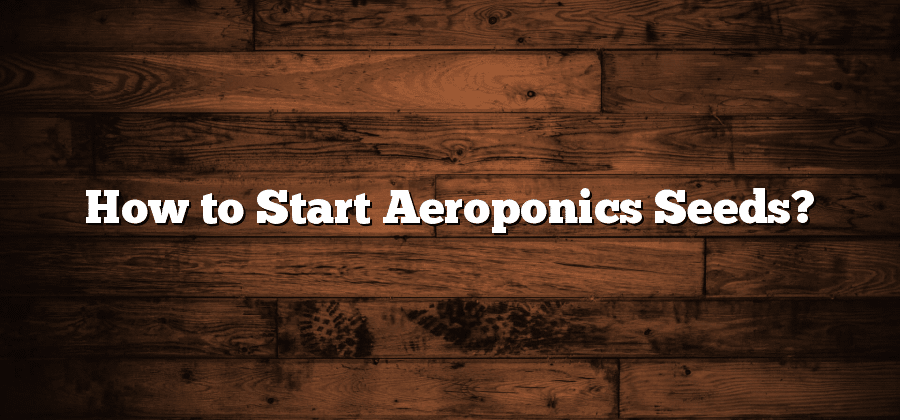Benefits of Starting Seeds with Aeroponics
Starting seeds with aeroponics offers countless benefits for both beginner and experienced growers alike. One of the key advantages is the accelerated growth rate that this method provides. With aeroponics, the seeds are suspended in air and misted with a nutrient-rich solution, allowing for direct absorption of nutrients and moisture. This process eliminates the need for soil, which often hinders the growth rate due to limited oxygen availability. As a result, plants cultivated through aeroponics tend to develop stronger root systems and experience enhanced nutrient uptake, leading to faster and healthier growth.
Another notable benefit of starting seeds with aeroponics is the significant reduction in diseases and pests. Traditional soil-based seed starting methods are more prone to issues like root rot, fungus, and insect infestations. However, by eliminating soil altogether, aeroponics eliminates these common pests that can harm plant health. Moreover, the constant exposure to the nutrient mist also helps strengthen the plant’s natural defense mechanisms, making them more resilient to potential diseases and pests. This allows growers to maintain a cleaner and more controlled environment, resulting in healthier crops and higher yields.
Selecting the Right Seeds for Aeroponics
Selecting the right seeds for aeroponics is a crucial first step in ensuring successful growth and harvest. When it comes to aeroponic systems, it is important to choose seeds that can thrive in this unique environment. It is recommended to opt for plants that have a shorter growing cycle and exhibit a high resistance to diseases and pests.
When choosing seeds for aeroponics, it is also essential to consider the size and space requirements of the plants. Since aeroponic systems typically have limited space, it is advisable to select seeds for plants that are compact and require less room to grow. Additionally, it is beneficial to opt for seeds that have been specifically bred or adapted for hydroponic or aeroponic cultivation. These seeds are often more resilient and have an increased likelihood of success in an aeroponic setup. Remember to select seeds that are suited to the climate conditions of your local area to optimize the growth potential of your aeroponic system.
Preparing the Aeroponic System
One crucial step in starting seeds with aeroponics is preparing the aeroponic system. This involves ensuring that all the necessary components are in place and properly working. Firstly, it is important to thoroughly clean and disinfect the aeroponic system to remove any potential contaminants or pathogens. This is especially crucial if the system has been previously used or if it has been stored for a prolonged period. By thoroughly cleaning the system, you can help create a clean and sterile environment for seed germination and growth.
Next, it is essential to properly set up the aeroponic system. This includes ensuring that the water reservoir is filled with clean, filtered water. It is recommended to use reverse osmosis water or distilled water to prevent the buildup of mineral deposits or impurities. Additionally, the nutrient solution should be mixed according to the manufacturer’s instructions and added to the water reservoir. The aeroponic system’s misters or sprayers should be checked to ensure that they are functioning correctly, providing a fine mist or spray that will effectively deliver water and nutrients to the seeds. By carefully preparing and setting up the aeroponic system, you can create an optimal environment for successful seed germination and growth.
Creating the Ideal Growing Environment for Aeroponics Seeds
When it comes to creating the ideal growing environment for aeroponics seeds, several factors need careful consideration. One of the most important aspects is the temperature. Aeroponics seeds thrive best in temperatures ranging from 70 to 80 degrees Fahrenheit (21 to 27 degrees Celsius). Maintaining a consistent temperature within this range is crucial for successful germination and growth.
Humidity is another critical factor for creating the ideal growing environment for aeroponics seeds. High humidity levels, typically around 50 to 70%, allow the seeds to absorb moisture effectively and develop strong roots. To achieve this, you may need to incorporate a humidifier or atomizer into your aeroponic system. Alternatively, covering the germination area with a transparent dome or plastic wrap can help retain moisture and increase humidity. However, it’s essential to monitor the humidity levels regularly as excessive moisture can lead to fungal infections and hinder germination.
Soaking Seeds for Optimum Germination
Soaking seeds before planting them is a crucial step in ensuring optimum germination in an aeroponic system. The process involves immersing the seeds in water for a specific period to soften their outer protective layer and kickstart the germination process. By providing the seeds with the right amount of moisture, they become more receptive to absorbing nutrients and growing into healthy plants.
When soaking seeds for aeroponics, it is important to follow a few guidelines. First, choose a suitable container that allows for easy drainage and airflow to prevent waterlogging. Fill the container with clean, room-temperature water and add the seeds, making sure they are fully submerged. The soaking duration will depend on the type of seeds being used, so it is crucial to consult the seed packet or reliable sources for the recommended soaking time. Once the soaking time is complete, carefully drain the water and transfer the seeds to the aeroponic system, ensuring they are positioned correctly for successful germination.






